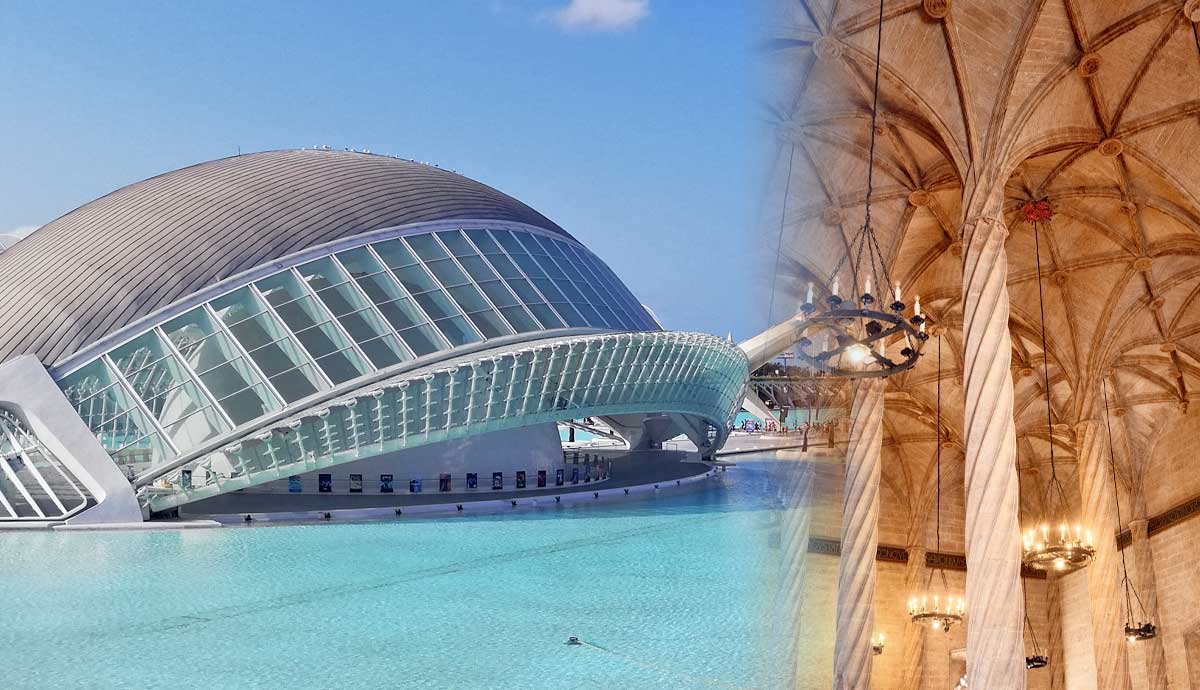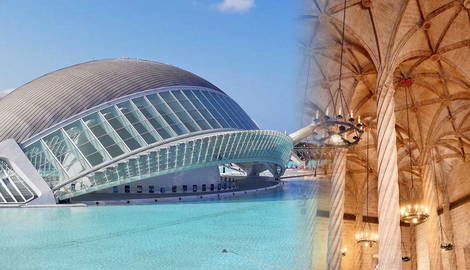
Valencia is a city with a rich history extending back more than 2,000 years. However, it also looks toward the future, and its architecture reveals this fact. Walk through the city to discover a 13th-century Gothic cathedral, remnants of a medieval city wall, 20th-century art nouveau landmarks, and the City of Arts and Sciences — an architectural complex so futuristic it was used as a filming location for Westworld.
1. Mercado Central

One of the oldest and largest markets in Europe, Mercado Central is worth visiting not just for its selection of food, but also to admire its design. Mercado Central is one of the prime examples of Valencian Art Nouveau architecture (also known as “Modernista” architecture), with a touch of Gothic.
Modernista architecture was popular around the turn of the 20th century and is characterized by the use of wrought iron, ceramics, stained glass, and organic motifs. These features are seen in the facade of the market which is decorated with ceramic tiles, the large central dome which features motifs of oranges and lemons—an ode to the agricultural product of the area—and the exposed steel girders on the ceiling.
2. The Silk Exchange

A UNESCO World Heritage Site, the Silk Exchange, or La Lonja, was once the financial center of the silk economy. The majority of La Lonja was built in the 15th century by architect Pere Comte, the leading architect of the Valencian Gothic style at the time. La Lonja is divided into four parts and one of the most stunning sections is the Hall of Columns, notable for its spiral columns which fan out to the vaulted ceilings, reminiscent of palm trees.
The Consulado del Mar was built adjoining the main building about 100 years later and displays a mix of Gothic and Renaissance style. The first floor of Consulado del Mar is home to the Golden Chamber, named as such because of its gilded and painted wooden ceiling.
3. Torres de Serranos

Torres de Serranos, or the Serranos Gate, is one of the original twelve gates of the ancient city wall that was built in the 14th century. The towers are one of the last remnants of the city wall which was taken down in 1865. The towers were not demolished as they were being used as a prison at the time.
The imposing Gothic towers were built by Valencian architect Pere Balaguer as a defensive structure, and it is the largest Gothic city gate in Europe. The back of the tower has been opened up so the vaulted domes are now visible. The tower is open for the public to climb, and provides a magnificent view of the city.
4. City of Arts and Sciences

Even those who have not been to Valencia may recognize the City of Arts and Sciences, as it was used as the filming location for Delo’s headquarters in the TV series, Westworld. The futuristic complex was designed by Santiago Calatrava and Felix Candela, and it stands in juxtaposition to Valencia’s historic landmarks. Calatrava is a Valencian-born architect and the City of Arts and Sciences is his largest project to date.

The complex consists of multiple structures built in stages since 1996. The newest building opened in 2009, and each looks like it belongs in a sci-fi novel. The first to open was L’Hemisfèric, which is meant to resemble a giant eye. The half-sphere is surrounded by a pool with a glass bottom, and the mirror image gives the illusion of a full eye. Other notable structures include the interactive science museum, built to resemble the skeleton of a whale.
5. Palacio Santa Clara

The only architectural landmark on this list that you can actually sleep in, Palacio Santa Clara was designed in 1916 by Francisco Javier Görlich. Francisco Javier Görlich is often credited for designing the “new Valencia” and showcasing different styles throughout his career. Palacio Santa Clara was originally designed as the private residence for the Niederleytner family and is another example of Modernista, or Valencian Art Nouveau, architecture.
The building is currently home to the Autograph Collection hotel, Palacio Santa Clara, and they have leaned into the Modernista style in their renovation and interior decoration. The on-site restaurant and bedrooms are furnished with antiques reminiscent of the Art Nouveau style.
6. Valencia Cathedral

Also known as St. Mary’s Cathedral, the Valencia Cathedral was consecrated in 1238. The majority of the cathedral was constructed between the 13th to 15th centuries, and this section primarily displays a Gothic architectural style. However, the cathedral had also undergone a number of renovations and additions, which reflect the changing trends in architectural style in Valencia.
The influence of the Renaissance Period can be seen in the decorations surrounding the altar. The main door of the cathedral was redesigned in 1703 in the Baroque style, while a renovation in the 18th century resulted in some Gothic elements being removed. At this point, the cathedral adopted a more neoclassical look but in 1972 some of the neoclassical elements were removed to bring the cathedral back to its original Gothic style.
7. The North Station

Most people who travel through Valencia will likely visit Valencia’s North Station, or Estacio del Nord. This is the major railway station in the city and it also happens to be one of the main examples of Valencian Art Nouveau architecture. The station was designed by architect Demetrio Ribes and it also encompasses aspects of Ribes’ Viennese Secession style.
The North Station opened in 1917 and was declared a historic monument in 1961. The facade is decorated with oranges, a nod to Valencia’s important agricultural product. The interior of the station is adorned with mosaics that reflect Valencian life at the time, with references to agriculture and the Albufera, a freshwater lagoon just outside of the city.
8. The Palace of the Marqués de Dos Aguas

The Palace of the Marqués de Dos Aguas was originally built in the 15th century with a Gothic facade and interior. Over the centuries, the mansion underwent a few renovations and now stands as one of Spain’s best examples of the ornate Rococo or Baroque style. The carved alabaster statues make for a grand entrance to the palace, with the Virgin of the Rosary presiding over the main door.
The Virgin of the Rosary was originally a wood sculpture made by Valencian Baroque sculptor Ignacio Vergara, but as the material did not stand the test of time, the current entrance features a plaster copy. A marbled stucco facade surrounding the balconies also gives the building a sense of opulence. The palace currently houses the National Museum of Ceramics and Decorative Arts, so the public can get a glimpse of the interior rooms, some of which still retain the original Gothic style.
9. Casa Judía

A rare example of Art Deco architecture in Valencia, Casa Judia was built in 1930 by Juan Guardiola Martinez, a Valencian architect. It also displays Neo-Egyptian elements. The colorful facade of this seven-story building is decorated with designs inspired by Egyptian and Arabic influences, among others. The top of the structure was also once adorned by Hindu-style finials, but they have since been removed.
The building got its name Casa Judia—the Jewish House—from the Star of David featured above the main entrance. It is said that the Star of David was requested by the original owner who commissioned the building, who happened to be Jewish. Casa Judia is a private property, but that doesn’t stop architecture lovers from appreciating it from the outside.
10. Plaza del Ayuntamiento

Plaza del Ayuntamiento is a square in the heart of Valencia that was initially designed by Francisco Javier Görlich. The square is surrounded by some impressive buildings from the 19th and 20th centuries. One of the most important structures here is the City Hall, which is made up of an 18th-century section connected to another section built at the beginning of the 20th century. The facade was added along with the new section in the 20th century and it features a Renaissance style.
Another important building here is the Palacio de Comunicaciones, which formerly served as the Central Post Office. The building was constructed beginning in 1915 by architect Miguel Angel Navarro and the eclectic design is reflective of the trend at the time. The sculptures on the facade feature symbols related to communication and transportation. One of the more unique aspects of the building is the metal tower that sits on top of the building, leading up to an observation deck.








